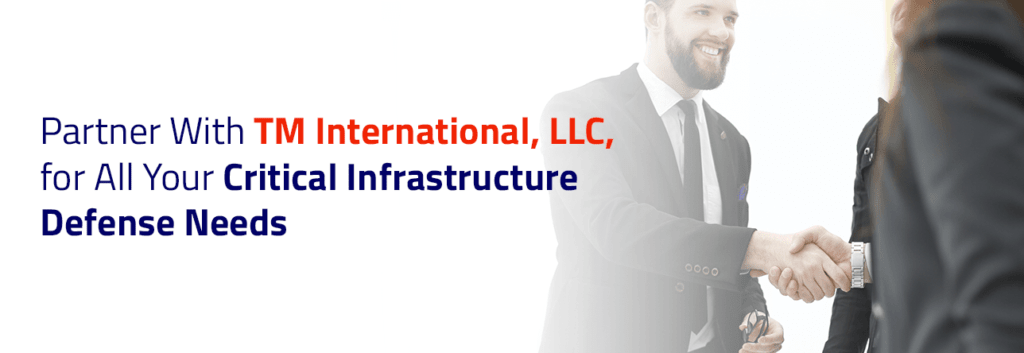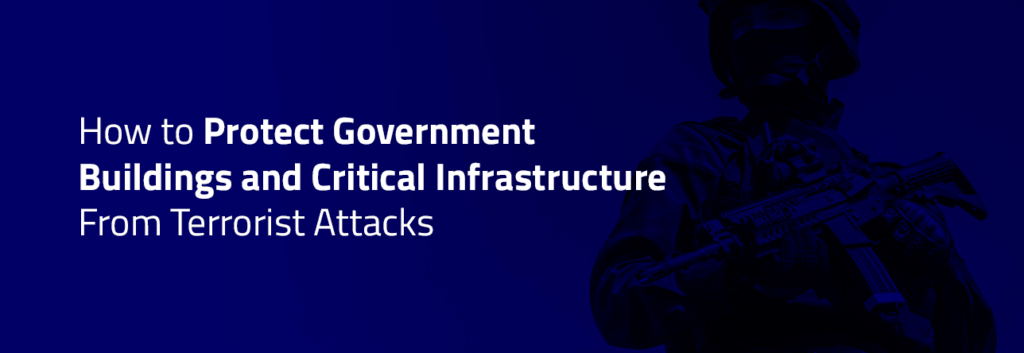 Without critical infrastructure, life in the United States would inevitably grind to a standstill. Supply chains would back up, the health care system would break down, hazardous materials would leak into cities and towns and government buildings would be reduced to piles of brick and concrete.
Without critical infrastructure, life in the United States would inevitably grind to a standstill. Supply chains would back up, the health care system would break down, hazardous materials would leak into cities and towns and government buildings would be reduced to piles of brick and concrete.
One large-scale chemical or nuclear accident, natural disaster or terrorist attack could make one or all of these scenarios a reality. An analysis of 1,000 terrorist attacks on transportation centers has found that 37 percent cause fatalities and attacks on other forms of infrastructure could result in loss of life, destruction of assets or disruption of social and economic activities, as well.
The question of how to protect government buildings from terrorist attacks is critical — but knowing how to defend critical infrastructure, like communications centers, the electric grid and hospitals, is just as important. Fortunately, facilities that are composed of or contain critical infrastructure can take steps to reduce potential damages.
In this guide, we'll discuss what critical infrastructure is and how we can protect our country's most valuable facilities and supply lines.
What Is Critical Infrastructure?
Critical infrastructure is any building or structure that is vital to the function of society or the economy. These structures are so essential to the country, that destroying or disabling them would be debilitating to our national security, safety, economic stability or public health.
According to the U.S. Cybersecurity and Infrastructure Security Agency (CISA), critical infrastructure can be broken down into 16 sectors:
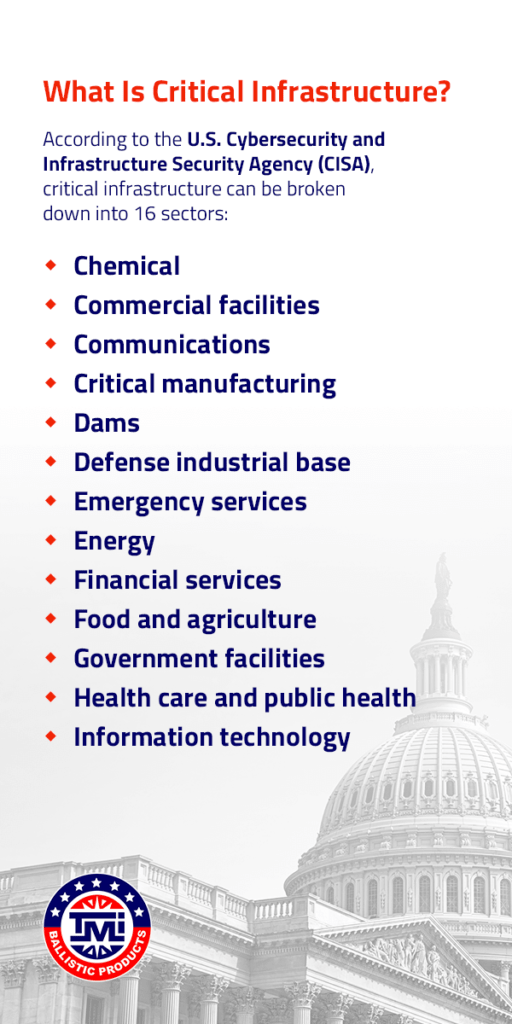
- Chemical sector: The chemical sector includes facilities that manufacture, store, use and transport the potentially hazardous chemicals required in other critical infrastructure sectors. Securing these hazardous chemicals against external threats is critical for the nation's security and public health.
- Commercial facilities sector: The commercial facilities sector encompasses locations that draw large masses for activities such as shopping, lodging, entertainment or business. The commercial facilities sector has eight sub-sectors: entertainment and media, lodging, outdoor events, gaming, public assembly, retail, real estate and sports leagues.
- Communications sector: The communications sector includes facilities that provide services such as voice communications, satellite transmissions and wireless transmission systems. These services have largely become interconnected, with providers sharing infrastructure and technology and prioritizing interoperability.
- Critical manufacturing sector: The critical manufacturing sector includes the manufacturing industry in the U.S. Large-scale disruptions to manufacturing could cripple the economy and pose a threat to the national defense.
- Dams sector: The dams sector includes the dams that retain water, control hydroelectric power generation, supply municipal and industrial water needs, provide irrigation and sediment control, allow river navigation for inland shipping and help manage industrial waste. The dams sector provides irrigation for at least 10 percent of the nation's cropland, protects almost half the country's population from flooding and generates about 60 percent of the power used in the Pacific Northwest.
- Defense industrial base sector: The defense industrial base sector includes military bases and their worldwide industrial complex. This military-industrial complex allows for the research and development, design, production, transport and maintenance of weapons systems and their parts. It also provides the capabilities necessary for mobilizing and deploying military operations.
- Emergency services sector: The emergency services sector includes trained emergency personnel and the facilities and resources necessary for them to carry out their duties. This sector includes both paid and volunteer organizations such as police departments, fire stations, sheriff's departments and public works departments. It also includes private sector groups such as industrial fire departments and private security organizations.
- Energy sector: The energy sector includes the infrastructure that generates and supplies fuels, electricity and other forms of energy to keep the country running. It is divided into the sub-sectors of electricity, oil and natural gas. The private sector owns more than 80 percent of this infrastructure.
- Financial services sector: The financial services sector includes the banks, investment businesses, insurance companies, credit organizations and other institutions that support the country's economy. These can range from multinational corporations with billions of dollars worth of assets to individual credit unions in small communities.
- Food and agriculture sector: The food and agriculture sector includes approximately 2.1 million farms, over 900,00 restaurants and 200,000 food-production and food-storage facilities. Taken together, these operations account for a fifth of the United States' economic activity.
- Government facilities sector: The government facilities sector includes the buildings, located both on U.S. soil and overseas, where operations of the federal, state, local and tribal governments take place. These structures might be office buildings, post office branches, military installations, courthouses, embassies or laboratories. Some are open for public use, while others house highly classified materials or equipment.
- Health care and public health sector: The health care and public health sector includes organizations that protect the country from the harms associated with infectious disease outbreaks, natural disasters and terrorism. This sector aids in response and recovery in all other sectors in the event of a natural or human-caused disaster.
- Information technology sector: The information technology sector includes organizations that provide hardware, software, internet services and information technology services. This sector consists of a complex, interwoven network of entities that makes robust threat protection essential.
- Nuclear reactors, materials and waste sector: The nuclear reactors, materials and waste sector includes 99 active and 18 decommissioning nuclear power reactors, 31 research and test reactors, and eight active nuclear cycle facilities. Nuclear power reactors generate almost 20 percent of the United States' electricity.
- Transportation systems sector: The transportation systems sector includes seven sub-sectors: postal and shipping, pipeline systems, mass transit and passenger rail, maritime transportation, highway and motor carrier, freight rail and aviation. It encompasses infrastructure such as airports, air traffic control systems, bridges, bus systems, freight cars and locomotives, fuel pipelines, highways, ports, postal services, tunnels, subway and light rail systems, railroads, waterways and more.
- Water and wastewater systems sector: The water and wastewater systems sector includes the 153,000 public drinking water systems and the 16,000 public wastewater treatment systems in the country. Municipal drinking water systems supply more than 80 percent of the U.S. population with their drinking water, and municipal wastewater treatment systems treat the sewage and wastewater of about 75 percent of the U.S. population.
Common Threats and Vulnerabilities of Critical Infrastructure
The critical infrastructure in the United States is vulnerable to a number of different threats.
Threats to Critical Infrastructure
Some of the external threats to critical infrastructure include the following:
- Accidental threats: Accidental threats are those caused by failures of infrastructure systems, including incidents such as air traffic control system failures, hazardous material accidents, pipeline leaks, power grid failures, safety system failures, water main breaks and water treatment facility failures.
- Human-caused threats: Human-caused threats are deliberate acts of disruption or destruction caused by such activities as attacks from explosive blast weapons, cyberattacks, financial crimes, rioting, terrorism and theft.
- Natural threats: Natural threats are those presented by natural disasters such as avalanches, droughts, earthquakes, floods, hurricanes, tornados, tsunamis, volcanic eruptions and wildfires. They can disrupt transportation and communication systems and destroy facilities across all sectors of critical infrastructure.
Vulnerabilities of Critical Infrastructure
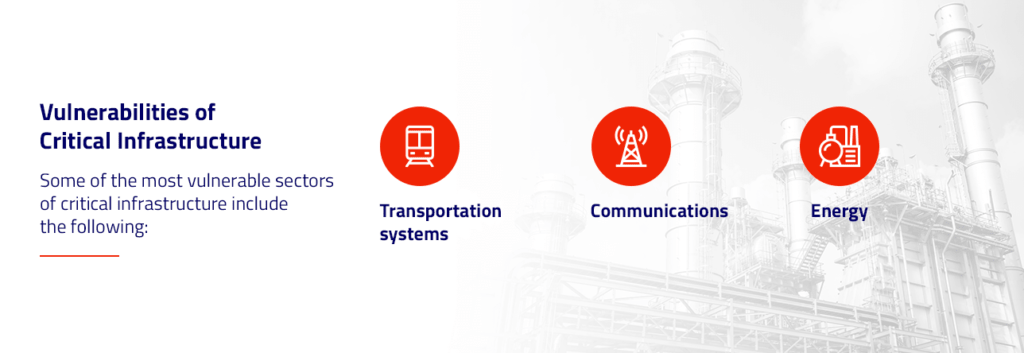
Some of the inherent vulnerabilities in critical infrastructure systems include the following:
- Excessive concentration: Many types of critical infrastructure highly concentrated in a single location. Therefore, a single attack, accident or disaster could disable a tremendous proportion of the critical infrastructure in question. For instance, many of the nation's oil refineries are clustered along the Texas and Louisiana coasts, where a single Category 4 or 5 hurricane could wipe out production capacities — and the ports of Los Angeles and Long Beach in California handle more than 40 percent of all shipping containers coming into the United States. A single disaster or targeted strike here could dramatically disrupt supply chains across the entire country.
- Outsourcing vulnerabilities: Ideally, the responsibility for maintaining critical infrastructure would rest in the hands of a small, trusted group of individuals. But many types of critical infrastructure, including cybersecurity, financial services, health care, security, transportation, utilities — are so complex to manage, that companies must outsource their work. This outsourcing creates more possibilities for compromised security, information leaks and direct attacks.
- Resource inequities: The realms of cybersecurity and physical security, in particular, see an uneven distribution of critical resources. Large corporations may easily afford the significant expenditures that adequate security requires. Smaller companies may struggle. This inequity leaves many smaller businesses vulnerable to both cyber and physical attacks.
Some of the most vulnerable sectors of critical infrastructure include the following:
- Communications: The communications sector is a vast, sprawling network that encompasses everything from voice communications to internet networks and extends across most other critical infrastructure sectors. Its extended and interconnected nature makes it particularly vulnerable at many points of control and contact. Cyberattacks can compromise communications infrastructure, but so can physical attacks. For instance, the 9/11 attacks knocked out 300,000 voice lines, 4.5 million data circuits and 10 cellular towers, leaving 14,000 businesses and 20,000 residential customers without service.
- Energy: The United States' power grid is aging and heavily dependent on computers, and these two vulnerabilities combine to increase the likelihood of widespread blackouts and brownouts. In 2003, the power outage that crippled the Northeast left more than 50 million people without power and cost the country between $7 and $10 billion. These vulnerabilities also extend to the nuclear reactors, materials and waste sector, where a single accident or targeted attack could have devastating consequences.
- Transportation systems: The transportation systems sector is also enormous, complex and interconnected with many other critical infrastructure sectors. As a result, it presents unique security and cybersecurity challenges. Air, railway and waterway traffic relies heavily on digital systems that are vulnerable to hacking attacks and other cyber threats. Freight cars and semitrailers on highways also frequently carry shipments of hazardous materials that could pose grave public health risks if an accident, attack or disaster occurs.
Mitigation Measures Against Terrorist Attacks
Of course, government and privately owned office and facility buildings across a wide range of critical infrastructure sectors are also vulnerable to attacks, particularly terrorist attacks. Below are some measures facilities can take to help mitigate damage from potential terrorist threats:
1. Regulatory Measures
Facilities can push for more stringent regulatory measures to help protect critical infrastructure. These measures might include the following:
- Legislation to protect against threats.
- Regulations, such as insurance requirements, to reduce the impact of harm from terrorist attacks.
- New or updated construction codes to make infrastructure more resistant to potential attacks.
- New or updated land use and zoning requirements to specify how land near critical infrastructure can be developed and used.
- Incentives to reward facilities for taking mitigation measures against terrorist attacks.
2. Repair and Strengthening of Existing Structures
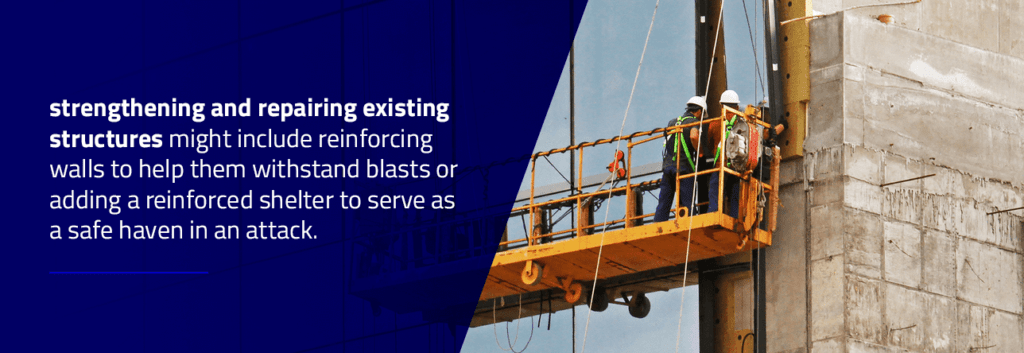
Facilities can also take the more direct step of making structural and nonstructural modifications to their existing buildings and infrastructure. These structural and nonstructural modifications improve the safety and integrity of buildings and infrastructure to which updated construction codes will not apply. Examples of useful modifications for strengthening and repairing existing structures might include reinforcing walls to help them withstand blasts or adding a reinforced shelter to serve as a safe haven in an attack.
3. Protective and Control Measures
Perhaps the most direct action critical infrastructure facilities can take to protect their buildings, supplies, equipment and personnel is to invest in protective and control measures designed to deflect the damage inflicted during a terrorist attack. These mitigation measures for terrorism might take a few different forms:
- Intelligence: Intelligence measures such as surveillance cameras, guards and sensors can provide a warning to help thwart an attack.
- Deception: Critical infrastructure facilities can employ deception tactics such as concealment and misdirecting signage to make the facility a less appealing target by causing it to seem unimportant. They can also use misdirection to make inessential areas of the facility appear critical, and critical areas appear inessential, thus making critical areas less attractive as targets.
- Physical fortifications: Purchasing equipment such as blast shields and walls and placing them strategically around sensitive areas to bolster those areas' defenses can help minimize damage and save lives.
Blast Shields and Walls for Building Protection Against Terrorism
To shield critical infrastructure against terrorist attacks, consider investing in blast shields and walls.
Blast shields and walls offer a unique wire rope construction to provide the highest level of protection against explosions. Our blast shields and walls can reduce peak blast pressure by 50 to 80 percent to minimize damage, protect property and save lives. They feature these design benefits:
- 5/8-inch galvanized independent wire rope core (IWRC) wire rope
- Capacity to absorb 6,500 J/cm2 of energy
- Fireproofing
- Lightweight construction for easy transport
- Modular construction with the option to link multiple panels for more comprehensive protection
- Simple, intuitive installation
- Venting of hazardous fumes
Our product designs also undergo rigorous testing before approval for use. Our blast shields and walls have held up under multiple 9,000 psi air blasts meant to simulate the tremendous blast pressure of a detonation or the impact of flying debris.
Partner With TM International, LLC, for All Your Critical Infrastructure Defense Needs
To help shield your critical infrastructure against potential attacks and accidents, partner with TM International, LLC. We provide locations such as airports, construction sites, military and government installations, mines, petrochemical facilities, and road cutting and drilling sites with the heavy-duty protection they need to resist the impact of bombings, chemical explosions or other disasters.
Contact us today to learn more.
